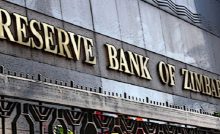Zimbabwe gets $210 million in foreign loans for projects
Zimbabwe has received $210 million in loans from external sources to finance various projects in the first six months of the year, the central bank said yesterday.
The southern African country has in recent times struggled to borrow due to a foreign debt overhang of about $9 billion.
Bretton Woods institutions, the World Bank and the International Monetary Fund, as well as traditional Western donors have withheld financial support from the country since 2000.
But Reserve Bank governor John Mangudya said in his mid-term monetary policy statement that the bank had negotiated with development financial institutions like PTA Bank, the African Export-Import Bank (Afreximabank) and the Development Bank of Belarus.
“Projects to be financed under this initiative would be made available to entities with both the ability and willingness to repay through normal banking channels,” said Mangudya.
Mangudya said the banking sector remains profitable, recording a net aggregate profit of $43 million in the first half of the year to 30 June compared to $26.53 million during the corresponding period last year.
Zimbabwe has 18 operational banking institutions, comprising 13 commercial banks, three building societies, one merchant bank, one savings bank following the cancellation of Allied and AfrAsia banks operating licences early this year.
The RBZ has cancelled licenses of six banks since 2012 — Allied, Trust, AfrAsia, Capital, Interfin and Royal — citing weak balance sheets.
In the first six months of the year, the sector recorded a 62 percent increase in aggregate net profit during the first half of the year with the exclusion of Tetrad Investment Bank which has been under provisional judicial management since 2014.
“The banking sector has demonstrated resilience against major shocks and has significantly contributed to the economic transformation of the real economy. The sector is poised for growth,” he said.
“Losses which were recorded by the remaining institutions were mainly attributed to increased levels of provisions. These provisions have been narrowing over the period under review.”
Mangudya said all operating banking institutions were in compliance with the prescribed minimum capital requirements with the sector’s aggregate core capital base increasing by 19 percent from $753.3 million last year to $899.10 million as at 30 June 2015.
“Growth in the aggregate core capital position was largely underpinned by increased retained earnings,” he said.
The interbank facility has so far raised $120 million of the $200 million target after five banks invested, Mangudya said.
Zimbabwe’s interbank market has not been functional since 2009 when the country adopted use of multi-currencies to replace its hyperinflation-ravaged local unit.
Three banks had so far borrowed $84 million from the facility, Mangudya added.-The Source
(768 VIEWS)
Recent Posts
Reserve Bank of Zimbabwe expects more foreign currency sellers to join the interbank market
The gazetting into law of the payment of quarterly taxes on a 50-50 basis in…
Zimbabwe 2025 citizens’ budget
Zimbabwe has today unveiled a ZiG276.4 billion budget for 2025 during which it expects the…
To go or not to go- Mnangagwa in a quandary
Zimbabwe President Emmerson Mnangagwa has repeatedly stated that he is not going to contest a…
ZiG loses steam, falls against US dollar for five consecutive days
The Zimbabwe Gold fell against the United States dollar for five consecutive days from Monday…
Indian think tank says Starlink is a wolf in sheep’s clothing
An Indian think tank has described Starlink, a satellite internet service provider which recently entered…
ZiG firms against US dollar for 10 days running but people still do not have confidence in the currency
Zimbabwe’s new currency, the Zimbabwe Gold (ZiG), firmed against the United States dollars for 10…



